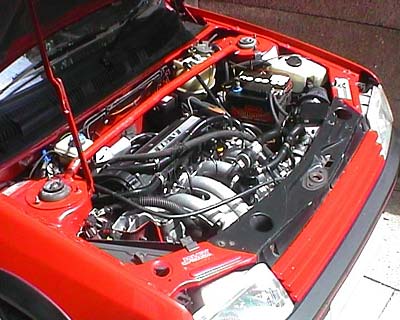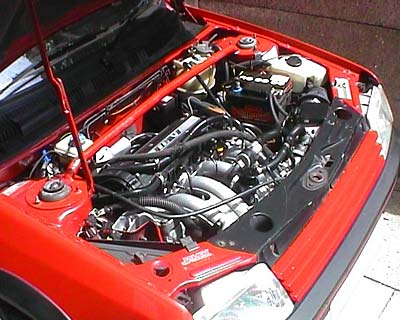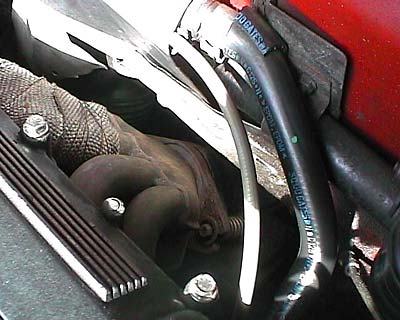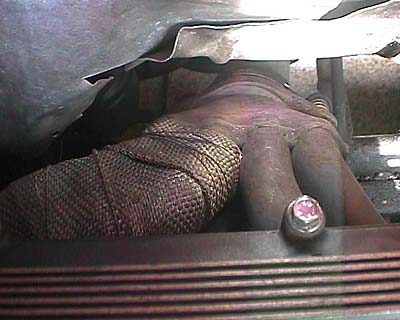
Introduction:
My 205 started out as a 1.9 GTI which ran fine without problems. One gripe I had with the 1.9 8v engine is that it didn't seem to want to rev even though I like torqey engines over high revs it still felt very flat around 6000 rpm. A rolling road session at Skip Brown made it pull like mad low down but the top end was the same (it was putting out the normal power for a 1.9). I'd always read about how the Mi16 is a relatively easy upgrade to 160 bhp but never thought about doing the conversion until I saw an engine for sale quite cheap. I bought it quite cheaply out of a H-reg BX 16v. Either the 1.6 or 1.9 GTI is suitable for an Mi16 conversion though the 1.9 is probably a better bet since it has discs all round and stronger driveshafts.

it's a tight fit...
The first and obvious thing to do is to source a 16v engine. The 1.9 Mi16 (160bhp, all alloy) was fitted to Citreon BX 16v's and 405 Mi16's from 88-92. This engine is lighter than the later 2-litre iron-block engine and also more powerful, if a little less torquey. Post 92 Mi16's had the iron-block engine (150 bhp) which wasn't fitted to the BX 16v. There are many ways to get hold of any engine; look in papers like LOOT for engines for sale or even a full car. Its not unknown for BX 16v's and even 405 Mi16's to be for sale for only a few hundred pounds. Having the complete car is obviously and advantage because you get all the parts for the conversion and don't need to hunt round ancillaries. You can also assess the condition of the engine and base this on whether you buy the car or not (unless you intend to rebuild it anyway). If you buy the engine seperately then try and get all the ancillaries with it (if you are using the Motronic injection) such as Airflow Meter (AFM), ECU, Idle Control Valve etc. Many parts can be used or made to fit from the 8v engine (eg Alternator) but not all.
Injection Systems:
There are two main injection systems to run the engine on; Bosch L-Jetronic (original 8v system) or Bosch Motronic (the Mi16 system). There are other systems to run the engine with though, such as throttle bodies using a mappable ECU (Emerald etc) or twin carbs. You can even have a mappable "piggy-back" system on top of the Motronic System (Dastek Unichip). When I first fitted mine I ran it on the 8v injection system, then later the Motronic system.
The main advantage of the Jetronic is that it requires less, if any, wiring since its all in the car anyway. You need a few extras though; a distributor adaptor which bolts onto the head where the distributor cap would normally go allowing the 8v distributor to fit, ideally a modified ECU with higher rev-limt (standard is 6500 rpm on 1.9 ECU) and a set of custom HT Leads. All of the 8v injection system is used (eg Airflow meter). The Supplementary Air Device (SAD) which normally sits at the side of the block under the distributor on the 8v can be fitted quite easily on top of the Mi16 inlet manifold in place of the Idle Control Valve. The Jetronic system also allows you to tune the timing which can't be done without a mappable ECU when using Motronic.

...but also looks like a factory fit!
To fit the Motronic injection system you will need all the Mi16 components including the loom. Wiring up the loom isn't too difficult, it just needs time and patience to work out which wire does what and mate part of the 8v loom to it. I've used an 405 Mi16 loom which is all contained in one neat loom and fits the 205 quite well without the need to shorten it. The main wires from the 8v that need to be stripped from the loom are the ignition, coil (and rev-counter) and the dash gauges and warning lights. So essentially only about 10 or so wires need to be connected to the end of the Mi16 loom since the engine side of the connections are within the Mi16 loom. There are about 7 or so different ECU's (going off Bosch codes) fitted to this engine in the BX and 405. I have 3 different ECU's and the main differences are the way the idle/low revs are controlled. They all drive the same apart from this. For example one ECU will occasionally stall the engine and another will hold the revs at 2000rpm and lower the revs very slowly and never stalls.

no space for the huge Mi16 airbox - K&N induction kit
Having driven the car using both systems I can say that there is very little difference between them in terms of ultimate power. Running the Jetronic seems to give more urge above 4000 rpm and the engine note sounded much deeper, the Motronic is smoother and gives a more reliable idle (with the right ECU) but doesn't give any more power top end on mine.
Gearbox, Flywheel & Clutch:
There are 3 main options (more if you are willing to experiment/change the gearbox internals):
- 1.6 GTI (18.7 mph / 1000 rpm)
- BX 16v/Mi16 (19.9 mph / 1000 rpm)
- 1.9 GTI (20.9 mph / 1000 rpm)
As it's a 16v engine, it likes to be kept in the powerband (i.e. higher revs) so a 1.6 gearbox would feel very quick and still give a reasonable top end though it might be a bit of a pain on longer journies. The 1.9 is longer in all gears (the main difference is a longer final drive) but they are very well spaced. The Mi16 g/box is an intermediate but has less linear ratios (i.e. 1st, 2nd and 3rd are shorter with 4th and 5th larger gaps but not too big). I'm using the 1.9 gearbox which is fine though I wouldn't mind trying a 1.6 gearbox'd 205 Mi16.
Each gearbox is essentially the same type so everything will fit. This includes the TDC sensor (sometimes the hole has to be drilled but its obvious where this is) and clutch actuation. The Mi16 clutch is bigger and you HAVE to use it when using the Motronic injection system, since the ignition is based on timing marks on the flywheel. Even if you are using the 8v injection there is no reason not to use the bigger clutch. It might be worthwhile having the flywheel refaced because mine suffered severe clutch judder which meant taking the gearbox off again later. I have also used the BX 16v clutch arm since its longer and simpler (no daft small bars and springs like the 8v). It gives a lighter clutch with slightly more travel and uses the cable stop under the battery tray giving better leverage.
Fitting the engine:
As the engine is essentially the same as the 8v engine (apart from the 16v head!) it fits pretty much straight in using the original mounts. There are few things to think about though; the exhaust manifold will foul the bulkhead and the inlet manifold will press against the radiator. There are many different methods in overcoming these problems:
- Exhaust manifold: You can tilt the engine slightly to clear the bulkhead by lengthening the bottom engine mount fork or modify the bulkhead (hammer it in - a lot), or modify the manifold itself by cutting and rewelding the joint end at a different angle. This is possible as it mild steel. The only drawbacks of tilting are the driveshafts run at more awkward angles and there is the possibility that under track driving you MAY see oil pressure loss.
- Inlet manifold: You can move the radiator forward a bit by grinding the fan shroud down or use a shortened inlet manifold which means it clears the radiator.

a problem on RHD cars - brake servo clearance
I have tilted the engine back a bit and used a modified exhaust downpipe. I've also used a shortened inlet manifold instead of moving the radiator. I put the engine in from the top, tilting it down at the gearbox end to get it under the inner wing.
I fitted the engine without the inlet manifold as this lets you wire everything up easier. You could wire the loom up before putting the engine in though.
Watch out for your oil cooler pipes too if the engine is tilted since it pushes them forward; one of mine rubbed on a sharp edge of the radiator and it split so started losing a lot oil.
- Alternator & belt: I have used the original 8v GTI alternator which is really the proper one for the engine (the Mi16 uses 4 rings on the pulleys compared with 3 for the GTI) but it fits using a standard 8v belt fine if you put the belt on the inner most 3 rings on the crankshaft pulley.
- Water pipes: I basically replicated the cooling system of the 8v GTI since many of the cooling pipes were missing. I got rid of the water cooled oil cooler and used the original air cooled unit. I also removed the metal pipe going round the back of the head and connected the heater pipe directly to the side of the head.
Conversion Part 2:
After 25,000 miles I wanted to change many things with the engine, mainly so it would be running as it was "meant" to. Also, as I wanted to changed the tappets, clutch etc and generally make more room to work on the engine I took the whole engine & gearbox out again.
To untilt the engine I put the original bottom fork/mount back on. This of course would bring the exhaust manifold in contact with the bulkhead (or at least right next to it). I didn't want to whack the bulkhead back, plus I wanted a decent amount of clearance so it looked proper so I decided that as the exhaust manifold is steel this could be modified instead. The manifold was cut along where the 8 pipes join to the flange that bolts to the head. With this cut cleanly off, just 3mm or so was ground off at an angle from each pipe (ie 3mm from the bottom of the pipes so it lowered the downpipe end of the manifold). The pipes were re-welded back on the flange.

modified exhaust manifold clears the bulkhead
It doesn't look much different but it now clears the bulkhead by about 1-2 inches and sits perfectly in between the subframe and bulkhead like it would do if it was standard. I bought a new downpipe which still needed modifying (as the Mi16 manifold is longer than the 8v). But this was fairly straight forward too as it just needed shortening rather than re-angling as well. Another bonus of the new downpipe was that it was an OE type which had the split down the middle which is a continuation of the manifold and is said to be best for engine power/torque output.

view from another angle
The main benefits of running the engine in its normal angle are:
- Better gearchange, especially into 2nd gear when accelerating
- Driveshafts run straighter
- Should be less chance of oil starvation.
As I'd been running on a shortened inlet manifold and felt sure that this was the reason it had poor mid-range power I wanted to try using the full length one I had spare. Many people run with a shortened inlet manifold and don't find they have poor mid-range but I wanted to swap mine just to be sure. This meant moving the radiator. I ground the fan and radiator surround so that the radiator sat close to the surround. It still uses the original locating slots at the bottom so I have, in effect, tilted the radiator forward by about 15mm at the top. A simple modification to the radiator retaining springs (shortening them) meant that it still fitted in the proper way. I also notice that there are large areas of solid plastic on the fan surround which covers the radiator; I used a circular drill bit to open these up which should give better airflow to the radiator.

inlet manifold sits _very_ close to radiator
There are 4 round plus in the inlet manifold which have lips that protrude slightly; this didn't help with the radiator clearance so I filed them flat so they wouldn't hit the radiator when the engine twists. I also had to make a new throttle cable as the old one was too short. So far I would say that the 4000-4500 rpm flat spot the engine suffered from has gone now. I'm not sure whether this is due to the longer manifold or the downpipe or a combination of the two but it does seem nice to drive around these revs. Before I either kept below 4000 rpm or had to go 5000 rpm plus to go fast. Low down and top end power seem the same.
I never ran the car with the 8v engine at trackdays or sprint tests so I can't compare the two engines but I would guess it is noticeable faster on track days and sprint tests than it is in everyday normal road use as the 1.9 8v has better low down and mid range (to a degree).
Sprint test results:
0-60: 6.37 seconds (Bruntingthorpe, April 2003)
0-100: 17.7 seconds, uphill, headwind (Bruntingthorpe, April 2003)
Standing 1/4 mile: 14.9 seconds (Shakespeare County raceway, 2002)
(Standard 1.9 Gti usually quoted as 16.4)

